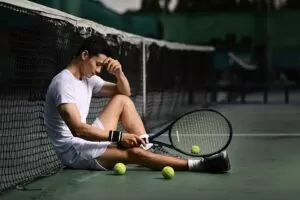Single and double tennis are both fun activities enthusiasts can enjoy professionally and as a hobby. As the name implies, singles tennis involves a single player on each side of the court, competing head-to-head. In contrast, doubles tennis requires a team of two players on each side, emphasising collaboration and teamwork.
Singles tennis is often seen as a test of individual skill and endurance. Players must rely on their abilities to cover the court, make strategic decisions, and outmanoeuvre their opponent. It’s a game of precision, agility, and mental acuity.
On the other hand, doubles tennis introduces a dynamic element with the presence of a partner. This format emphasises communication and coordination between the team members. Players must work together seamlessly, covering their respective court areas, setting up opportunities for each other, and responding to their opponent’s moves. Doubles tennis is physically demanding and a test of synergy between teammates.
Whether you favour the competitiveness of singles tennis or the tactical difficulties of doubles tennis, both variations of the sport provide distinct experiences and chances for development. Tennis is a sport that has something to offer everyone, regardless of whether you play for a living or just for fun. It is a beloved pastime worldwide because it promotes mental acuity, physical fitness, and the love of competition.
Playing Field: Individual vs. Team
Do you play better alone, or prefer having two heads and two talents in one team? If you plan to choose between singles and doubles tennis, this is the question.
Singles tennis can be incredibly rewarding for people who enjoy being in the spotlight and the challenge of accepting complete responsibility for their performance. You face your opponent alone on the court in a match of wits and physical might, with no support from anybody else. Each point you earn is evidence of your unique talent, plan, and tenacity.
On the other hand, doubles tennis provides a special connection that is challenging to match in singles. You share the court with a partner who accentuates your deficiencies and plays to your strengths. You collaborate, communicate, and enjoy success as a team. When playing doubles, the chemistry between partners can be a tremendous source of satisfaction as you work together to coordinate moves, carry out complex strategies, and depend on one another’s abilities to win.
Singles Tennis
Singles tennis is one of the most traditional and widely played tennis formats worldwide. It focuses on individual skill, agility, strategy, and endurance, as each player is responsible for covering the entire court and making strategic decisions independently.
Australia has a long tennis history, and singles tennis is well-liked there. Tennis players of Australia’s highest calibre have excelled in singles and doubles competitions. Tennis is a popular sport, and numerous tennis clubs and facilities are spread nationwide.
The Australian Open, one of the four Grand Slam competitions, is held annually in Melbourne. The Australian Open draws star athletes from all over the world and has a global audience. The tournament’s success helped tennis gain popularity in Australia and motivated future generations of tennis fans.
Additionally, Australia’s warm climate and outdoor lifestyle make it conducive to tennis, with many people participating in the sport recreationally. Tennis courts can be found in parks, schools, and private clubs throughout the country, making them accessible to many players.
Doubles Tennis
Doubles tennis is a sport in which two teams, each with two players, compete against one another. As players share the court with a partner, doubles tennis promotes cooperation, communication, and teamwork as opposed to singles tennis, which emphasises individual performance.
Tennis, including doubles tennis, is rooted in several ball and racket games popular in Europe during the Middle Ages. Doubles tennis became a distinctive format as the game developed and grew more organised. Along with singles tennis, it grew in popularity, especially during the 19th century, when tennis was structured and standardised in England.
Fast-paced exchanges, complex net play, and strategic cooperation between partners define doubles tennis. The sport’s most cherished format highlights the social and competitive sides of tennis.
Australia has a rich history of success in doubles tennis, with many pairs achieving international acclaim. The country’s tennis clubs and facilities often promote doubles play, providing opportunities for players to develop their teamwork and coordination skills.
The country’s love for doubles tennis is further demonstrated by its inclusion in prestigious tournaments like the Australian Open. The tournament features both men’s and women’s doubles events, where top players worldwide partner up to compete.
Court Coverage and Movement
Court coverage and movement are fundamental aspects of tennis that can make the difference between victory and defeat on the court. Players must possess exceptional shot-making skills and the ability to navigate the court efficiently. Whether sprinting to reach a wide forehand, executing a perfectly timed split step, or seamlessly transitioning from defence to offence, court coverage and movement are the building blocks of a successful tennis game.
Singles Tennis
In singles tennis, court coverage, and movement are pivotal skills that define a player’s success. Unlike doubles, where players share responsibilities, singles players must cover the entire court alone. This places a premium on agility, endurance, and strategic positioning.
Court coverage and mobility in singles tennis include a variety of crucial abilities. The ability to successfully traverse the width of the court requires quick side-to-side transitions, which are especially important when retrieving wide shots like deep backhands or strong cross court forehands.
Transitioning from the baseline to the net or vice versa involves precise footwork, essential for approaches to finish points or quick retreats to defend lobs. The split step, a critical aspect of court coverage, consists of a small hop made just before the opponent strikes the ball, enabling rapid reactions to the ball’s trajectory and direction. Understanding when to employ cross-court shots versus down-the-line shots is pivotal, influencing both offensive and defensive strategies and requiring anticipatory positioning.
Doubles Tennis
Teamwork on the court creates a special dynamic that makes court coverage and mobility equally important in doubles tennis. For effective court coverage in doubles, players must cooperate with their partner instead of singles, when players are exclusively responsible for covering the full court.
Effective court coverage and movement in doubles tennis require a seamless blend of coordination, communication, and strategic positioning. Partners must synchronise their movements to cover the court effectively, especially when dealing with wide shots, whether a powerful cross court forehand or a deep backhand.
Transitioning from the baseline to the net or vice versa is a coordinated effort, demanding precise footwork and well-timed adjustments. Approaching the net to seize control of the point or swiftly moving back to defend against lobs necessitates cooperation and quick decision-making.
Strategy and Decision-Making
Strategy and decision-making are critical elements that can determine both singles and doubles tennis success. These aspects of the game require a combination of mental acuity, adaptability, and the ability to read the flow of a match.
Singles Tennis
Players in singles tennis need to develop a plan that plays to their advantage and takes advantage of those of their rivals. This entails analysing the opponent’s play style, spotting weaknesses, and modifying strategies as necessary. In singles tennis, choices on when to attack the net, when to play defensively from the baseline, and when to alter the match’s tempo are crucial.
Singles players also need a strong mental game because they don’t have a partner to lean on for moral support or encouragement when things become tough. It can differ between success and failure to maintain composure under pressure, make split-second judgements, and adjust to changing conditions.
Doubles Tennis
In doubles tennis, strategy and decision-making take on a different dimension due to the partnership aspect of the game. Successful doubles teams develop strategies that maximise their strengths as a pair, such as one player dominating the net while the other covers the baseline. Decisions are often made in real-time, requiring effective communication and partner coordination.
Doubles players must constantly assess their opponents’ and partners’ positioning to execute effective strategies. Deciding when to poach (move to intercept the opponent’s shot), when to switch sides during a point, and when to play aggressively or defensively are all crucial decisions.
Communication and Coordination
Communication is key to success in winning a doubles’ tennis game. Unlike singles, where the player stands alone, doubles requires a partnership where both individuals must work harmoniously to outmanoeuvre their opponents.
Doubles Tennis
Effective communication starts with understanding your partner’s game and tendencies. Doubles players often develop unspoken signals and gestures to convey their intentions on the court. This includes indicating who will take a shot, whether to poach (move to intercept the opponent’s shot), or when to switch sides during a point. Clear and seamless communication ensures that both players are on the same page, reducing errors and increasing the team’s efficiency.
Coordination goes hand in hand with communication. It involves synchronised movements and positioning. Doubles partners must cover the court strategically, with one player often at the net and the other at the baseline. Coordination in movement helps maximise court coverage and sets up opportunities for attacking the net or defending against opposing shots. It’s a dance of sorts, where both players must move in rhythm, responding to the flow of the match.
Net Play and Serve-and-Volley
Net play and serve-and-volley are dynamic components distinguishing doubles tennis from its singles’ counterpart. These strategies centre around aggressive positioning at the net, emphasising quick reflexes and precision.
Doubles Tennis
Net play involves venturing towards the net to seize control of the point. Effective net players can intercept shots with volleys and smashes, putting pressure on their opponents. In doubles, a skilled net player can disrupt the opponent’s rhythm, closing off angles and creating opportunities for their partner at the baseline. It’s a high-risk, high-reward strategy that requires confidence and timing.
On the other hand, serve-and-volley is a tactic used primarily during serves. The server hurries to the net after a strong serve to take advantage of the weak return and put pressure on the adversary. This tactic can be successful in doubles because it not only puts pressure on the returner but also compels the opposition team to act quickly, frequently resulting in misunderstandings and mistakes.
In doubles tennis, both net play and serve-and-volley strategies necessitate flawless teamwork. Together, with the exact time and anticipation of the return, the server and net player must perform. These tactics are effective weapons in the doubles player’s toolbox because they can alter the course of a game in your favour.
Dynamics of Tennis: Singles vs. Doubles
In conclusion, tennis offers a captivating blend of individual skill, teamwork, and strategy, whether in singles tennis or the dynamic landscape of doubles tennis. Each format has unique challenges and demands, from the comprehensive court coverage and mental fortitude required in singles to the synchronised communication and coordination vital in doubles. Strategy and decision-making are the linchpins of success in both, shaping the flow of the game and guiding players to victory.
Tennis continues to be a sport that enthrals players and spectators alike, whether you prefer the lonesome journey of singles or the thrilling companionship of doubles. It’s an activity that calls for physical strength, mental flexibility, adaptation, and the capacity for communication with your doubles partner. Tennis, in all its forms, invites people to put their skills to the test, value cooperation, and savour the thrill of competition on the revered courts.





